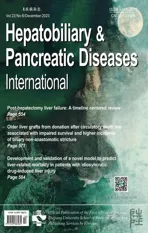Endoscopic retrograde cholangiopancreatography management for choledochocele in a young female
2024-01-21LinPingCaoXunZhongKangJieChenJunYu
Lin-Ping Cao,Xun Zhong,Kang-Jie Chen,Jun Yu
Department of Hepatobiliary and Pancreatic Surgery,the First Affiliated Hospital,Zhejiang University School of Medicine,Hangzhou 310 0 03,China
TotheEditor:
Choledochocele,also known as type III choledochal cysts in the classification by Todani et al.[1],is a congenital abnormality of the biliary system.It is characterized by a cystic dilation of intramural segment of the distal common bile duct (CBD) protruding into the descending duodenum.Choledochocele makes up about 0.5% -4% of choledochal cysts [1,2].Compared with other subtypes,the incidence of choledochocele is extremely low and it frequently presents in adults at a relatively older age,with an average age of 51 years [3].The diagnosis and treatment are challenging.Here,we present a case of a young female patient with this rare disease entity,who recovered after effective endoscopic retrograde cholangiopancreatography (ERCP) management.
A 32-year-old woman was referred to our hospital for intermittent dull abdominal pain for a few months.Physical examination revealed no obvious abnormalities.Routine blood,liver function and tumor markers were all within the normal range.There was no other significant medical history.The abdominal contrastenhanced computed tomography (CT) imaging revealed dilation of the descending and horizontal part of duodenum,which presented as duodenal intussusception,tumors cannot be excluded (Fig.1 A and B).For further exploration,the patient received ERCP and endoscopy found a huge mucosal bulging connected to the major duodenal papilla at the second portion of duodenum (Fig.1 C).The mucosal bulging became flat when extruded by the endoscope(Fig.1 D).After cannulation,cholangiography demonstrated that the cyst was directly communicated with dilated CBD (Fig.1 E).The cyst ballooned when contrast medium was injected into the bile duct.An endoscopic nasobiliary drainage tube and a pancreatic stent were placed for fully bile drainage and preventing pancreatitis,respectively.A multidisciplinary team discussion confirmed the diagnosis as a type A choledochocele based on cholangiography under ERCP and suggested endoscopic sphincterotomy as further treatment.During the procedure,the snare was applied to the root of the choledochocele,and the cyst was completely excised in the excision and coagulation mixed mode (Fig.1 F).The guide wire entered the biliary tract through the cyst incision,and Xray confirmed the direct communication between the cyst and the CBD (Fig.1 G).No oozing of blood was observed on the duodenal papilla wound and biliary stent was not placed.Unfortunately,the patient developed bleeding 2 days later and hemoglobin dropped from 118 g/L to 95 g/L.An emergency ERCP was performed for endoscopic hemostasis.Eventually,the patient recovered and was discharged a few days later.Pathological examination of the specimen showed bile duct mucosa and duodenal mucosa (Fig.1 H).The latest follow-up showed no recurrent abdominal pain or other new clinical symptoms.
Choledochocele is a benign disease,with a risk of biliary malignancy.However,choledochocele is unique for its even sex distribution and low incidence of malignancy (2.5%) [4].Sarris and Tsang [5]described a new classification of choledochoceles into type A and type B lesion based on the anatomic morphology.Type A is the cystic bile duct dilation which has individual orifice communicated to the duodenal lumen.Type B is characterized by the ampulla that opens directly into the duodenal lumen,with the cyst arising as a diverticulum of the distal bile duct protruding into the duodenal lumen.Our case belongs to type A.Abdominal discomfort is the most common symptom for choledochocele.Others include concomitant nausea,vomiting and jaundice,which may vary widely.Also a few patients may be asymptomatic.The clinical complications of choledochocele include choledocholithiasis,cholangitis and pancreatitis [6,7].In our case,the patient primarily presented with the unique symptom of intermittent dull abdominal pain.A variety of imaging examinations play an important role in the diagnosis.Ultrasound is one of the most commonly used method for the primary detection of cystic mass.However,due to the intestinal gas accumulation,lesions cannot be correctly identified.CT and magnetic resonance cholangiopancreatography (MRCP) are more accurate than ultrasound which can assess the cyst location,size and shape of bile duct dilatation.Both examinations are noninvasive and convenient,which are considered with comparable specificity and sensitivity in the diagnosis of choledochocele [8].Although there are many noninvasive examinations,the most widely used confirmation of choledochocele appears to be best made by ERCP.It also provides the possibility for treatment of the lesion because endoscopic sphincterotomy can be done concomitantly [9,10].There were no specific findings on ultrasound scan in our patient and CT scan showed duodenal intussusception.The further diagnosis of type A choledochocele was finally confirmed by ERCP.
Endoscopic sphincterotomy,unroofing and/or cyst resection could be considered in surgical therapy of choledochocele [11–13].Whether open surgical resection or conservative endoscopic therapy is still controversial.It depends on many aspects,such as patient’s age,symptoms,size of the cyst and the relationship between the bile duct and duodenal papilla.In view of the rare risk of malignancy,Deyhle et al.[14]first proposed endoscopic sphincterotomy treatment for choledochocele in 1974.From then on,conservative endoscopic sphincterotomy has been recognized as an effective treatment in most patients,especially in cases of smaller(<2 cm),and uncomplicated choledochoceles.After the multidisciplinary team discussion,we performed endoscopic cyst resection,and final intubation cholangiography confirmed that the cyst had direct communication with the CBD.
In conclusion,choledochocele is a relatively rare entity in clinical practice.Our case demonstrated that ERCP is an effective and safe method for the diagnosis and treatment of type A choledochocele with minimal invasiveness and satisfactory results.
Acknowledgments
None.
CRediTauthorshipcontributionstatement
Lin-PingCao:Data curation,Formal analysis,Funding acquisition,Writing -original draft.XunZhong:Formal analysis,Writing-original draft.Kang-JieChen:Investigation,Writing -review &editing.JunYu:Conceptualization,Supervision,Writing -review &editing.
Funding
This study was supported by a grant from the Natural Science Foundation of Zhejiang Province (LQ21H160025).
Ethicalapproval
Written informed consent was obtained from the patient for publication of this report.
Competinginterest
No benefits in any form have been received or will be received from a commercial party related directly or indirectly to the subject of this article.
